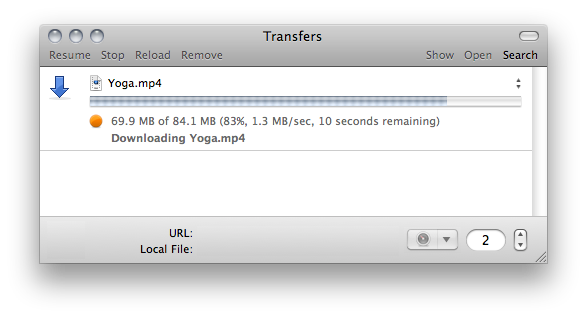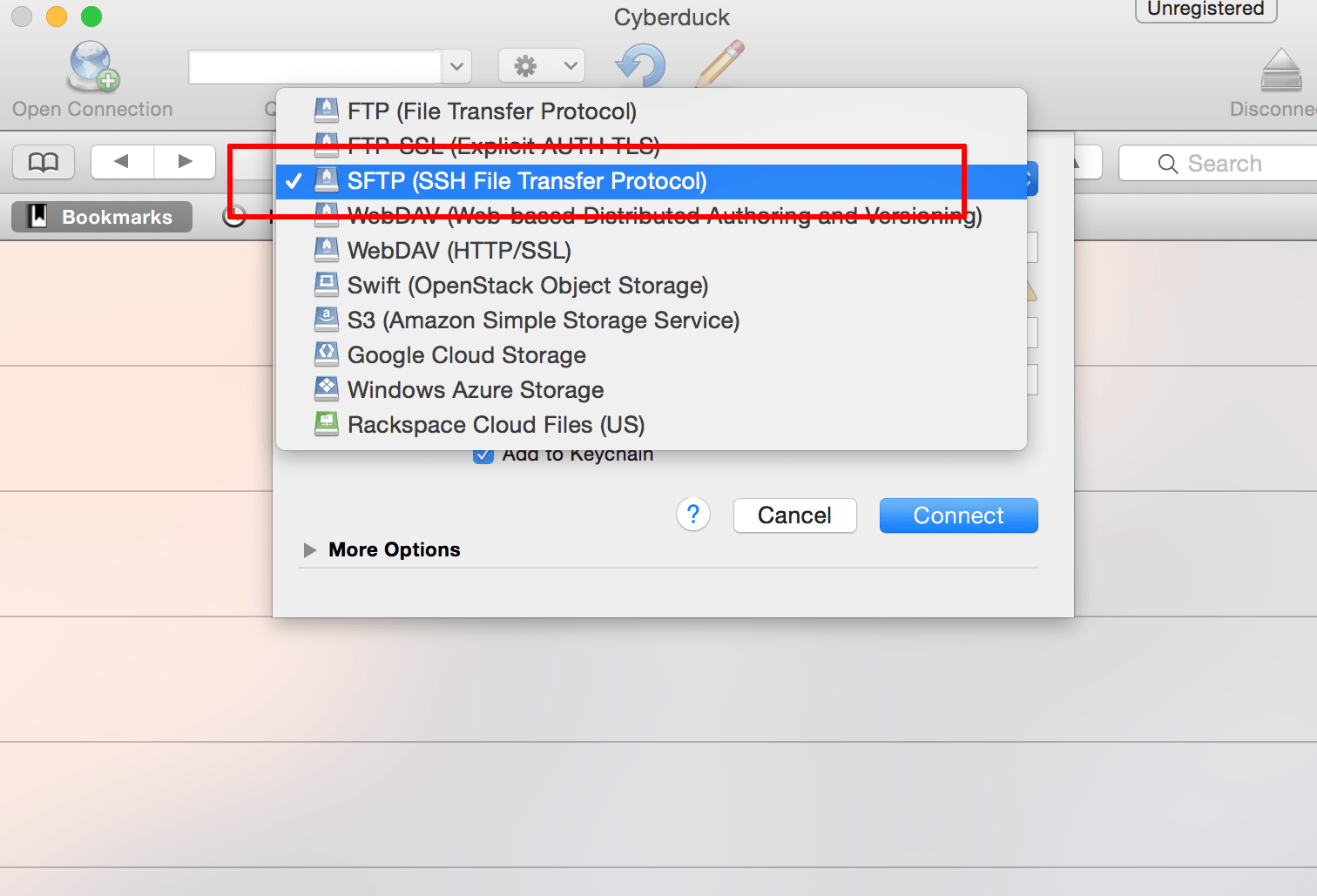- Cyberduck is a libre server and cloud storage browser for Mac and Windows with support for FTP, SFTP, WebDAV, Amazon S3, OpenStack Swift, Backblaze B2, Microsoft Azure & OneDrive, Google Drive and Dropbox. Cyberduck Mountain Duck CLI Connecting to every server.
- Cyberduck - SFTP/FTP Client for Mac Cyberduck is a fairly popular file transfer client for Apple Mac and Microsoft Windows. It supports FTP, SFTP, WebDAV, Amazon S3, OpenStack Swift, Backblaze B2, Microsoft Azure & OneDrive, Google Drive and Dropbox. Cyberduck was built by David V. Kocher, Yves Langisch, and iterate GmbH.
Cyberduck is a GUI file transfer software that can be used to copy files to remote servers using SFTP that is available for both Windows and Macintosh clients.
Feb 03, 2006 sftp (command line) is around 5MB/s when cyberduck is around 80KB/s on the same file in SFTP mode and 300KB/s for scp mode. Worst: If I try the 3.7 ( r7380 ) then the SFTP mode give me 150KB/s and scp one around 300KB/s. Looks like a regression to me, or?
All modern operating system platforms now have native support for command line SFTP file copies, but most users will want a GUI client for drag and drop file copy between hosts. Windows and Apple users must use a third party application (like cyberduck or winscp), to provide file browser application - Linux users can use the native 'Nautilus' file browser which supports SFTP.

SFTP using Cyberduck
Download and install cyberduck. Click the Open Connection icon and select SFTP (SSH File Transfer Protocol) from the drop-down list of protocols. Click the More Options button at the bottom of the dialog box.
Enter the server address information, your Netlink or COSI credentials.
- For web publishing to a personal webhome directory, specify the server as sftp.csc.uvic.ca (or sftp.cs.uvic.ca for COSI domain), and /public_html as the destination path for the file copy.
- For web publishing to a shared group website, specify he server as sftp.csc.uvic.ca (or sftp.cs.uvic.ca for COSI domain), and /htdocs as the destination path.
- For copying data to or from your Department Home directory, connect to one of the Department's linux login servers as the destination server, and leave the destination path blank (it will default to your home directory).
- For copying data to or from a COSI Shared Group directory, connect to the COSI linux.cs.uvic.ca login server, and specify the destination path as /groups/cosi_
researchgroup.
SSH-Keys with Cyberduck
If you intend to use an SSH-KEY, click the checkbox for Use Public Key Authentication, and select your private SSH-KEY file from the file prompt dialog (if you have a passphrase on your private key, you will be prompted when you connect).

Once connected, you can drag and drop files back and forth from the Windows file explorer to the cyberduck file window.
More Information
Tutorial: Authenticating with SSH-Keys
Support: Department Network Storage
Support: Web Publishing to Department Web Servers
NOTE: Bitnami applications can be found in /opt/bitnami/apps.
The first step is to ensure that you have an SSH key for your server.
If you are using the Bitnami Launchpad for AWS Cloud, download the SSH key for your server in .ppk format (for FileZilla or WinSCP) or in .pem format (for Cyberduck) from the Launchpad detail page for your server.
Although you can use any SFTP/SCP client to transfer files to your server, this guide documents FileZilla (Windows, Linux and Mac OS X), WinSCP (Windows) and Cyberduck (Mac OS X).
Using an SSH Key
NOTE: The steps below assume that you have obtained the SSH credentials for your server. Learn more about obtaining SSH credentials
Once you have your server's SSH key, choose your preferred application and follow the steps below to connect to the server using SFTP.
FileZilla
IMPORTANT: To use FileZilla, your server private key should be in PPK format.
Follow these steps:
Download and install FileZilla.
Launch FileZilla and use the 'Edit -> Settings' command to bring up FileZilla's configuration settings.
Within the 'Connection -> SFTP' section, use the 'Add keyfile' command to select the private key file for the server. FileZilla will use this private key to log in to the server.
Use the 'File -> Site Manager -> New Site' command to bring up the FileZilla Site Manager, where you can set up a connection to your server.
Enter your server host name and specify bitnami as the user name.
Select 'SFTP' as the protocol and 'Ask for password' as the logon type.
Use the 'Connect' button to connect to the server and begin an SFTP session. You might need to accept the server key, by clicking 'Yes' or 'OK' to proceed.

You should now be logged into the /home/bitnami directory on the server. You can now transfer files by dragging and dropping them from the local server window to the remote server window.
If you have problems accessing your server, get extra information by use the 'Edit -> Settings -> Debug' menu to activate FileZilla's debug log.

WinSCP

SFTP using Cyberduck
Download and install cyberduck. Click the Open Connection icon and select SFTP (SSH File Transfer Protocol) from the drop-down list of protocols. Click the More Options button at the bottom of the dialog box.
Enter the server address information, your Netlink or COSI credentials.
- For web publishing to a personal webhome directory, specify the server as sftp.csc.uvic.ca (or sftp.cs.uvic.ca for COSI domain), and /public_html as the destination path for the file copy.
- For web publishing to a shared group website, specify he server as sftp.csc.uvic.ca (or sftp.cs.uvic.ca for COSI domain), and /htdocs as the destination path.
- For copying data to or from your Department Home directory, connect to one of the Department's linux login servers as the destination server, and leave the destination path blank (it will default to your home directory).
- For copying data to or from a COSI Shared Group directory, connect to the COSI linux.cs.uvic.ca login server, and specify the destination path as /groups/cosi_
researchgroup.
SSH-Keys with Cyberduck
If you intend to use an SSH-KEY, click the checkbox for Use Public Key Authentication, and select your private SSH-KEY file from the file prompt dialog (if you have a passphrase on your private key, you will be prompted when you connect).
Once connected, you can drag and drop files back and forth from the Windows file explorer to the cyberduck file window.
More Information
Tutorial: Authenticating with SSH-Keys
Support: Department Network Storage
Support: Web Publishing to Department Web Servers
NOTE: Bitnami applications can be found in /opt/bitnami/apps.
The first step is to ensure that you have an SSH key for your server.
If you are using the Bitnami Launchpad for AWS Cloud, download the SSH key for your server in .ppk format (for FileZilla or WinSCP) or in .pem format (for Cyberduck) from the Launchpad detail page for your server.
Although you can use any SFTP/SCP client to transfer files to your server, this guide documents FileZilla (Windows, Linux and Mac OS X), WinSCP (Windows) and Cyberduck (Mac OS X).
Using an SSH Key
NOTE: The steps below assume that you have obtained the SSH credentials for your server. Learn more about obtaining SSH credentials
Once you have your server's SSH key, choose your preferred application and follow the steps below to connect to the server using SFTP.
FileZilla
IMPORTANT: To use FileZilla, your server private key should be in PPK format.
Follow these steps:
Download and install FileZilla.
Launch FileZilla and use the 'Edit -> Settings' command to bring up FileZilla's configuration settings.
Within the 'Connection -> SFTP' section, use the 'Add keyfile' command to select the private key file for the server. FileZilla will use this private key to log in to the server.
Use the 'File -> Site Manager -> New Site' command to bring up the FileZilla Site Manager, where you can set up a connection to your server.
Enter your server host name and specify bitnami as the user name.
Select 'SFTP' as the protocol and 'Ask for password' as the logon type.
Use the 'Connect' button to connect to the server and begin an SFTP session. You might need to accept the server key, by clicking 'Yes' or 'OK' to proceed.
You should now be logged into the /home/bitnami directory on the server. You can now transfer files by dragging and dropping them from the local server window to the remote server window.
If you have problems accessing your server, get extra information by use the 'Edit -> Settings -> Debug' menu to activate FileZilla's debug log.
WinSCP
IMPORTANT: To use WinSCP, your server private key should be in PPK format.
Follow these steps:
Download and install WinSCP.
Launch WinSCP and in the 'Session' panel, select 'SCP' as the file protocol.
Enter your server host name and specify bitnami as the user name.
Click the 'Advanced…' button and within the 'SSH -> Authentication -> Authentication parameters' section, select the private key file for the server. WinSCP will use this private key to log in to the server.
From the 'Session' panel, use the 'Login' button to connect to the server and begin an SCP session.
You should now be logged into the /home/bitnami directory on the server. You can now transfer files by dragging and dropping them from the local server window to the remote server window.
If you need to upload files to a location where the user doesn't have write permissions, you have two options:
Once you have configured WinSCP as described above, click the 'Advanced…' button and within the 'Environment -> Shell' panel, select sudo su - as your shell. This will allow you to upload files using the administrator account.
Upload the files to the /home/bitnami directory as usual. Then, connect via SSH and move the files to the desired location with the sudo command, as shown below. Replace the FILENAME placeholder with the actual name of the file being moved.
Cyberduck
IMPORTANT: To use Cyberduck, your server private key should be in PEM format.
Cyberduck Sftp Tutorial
Follow these steps:
Select the 'Open Connection' command and specify 'SFTP' as the connection protocol.
In the connection details panel, under the 'More Options' section, enable the 'Use Public Key Authentication' option and specify the path to the private key file for the server.
Use the 'Connect' button to connect to the server and begin an SFTP session.
Cyberduck Sftp Connection Failed
You should now be logged into the /home/bitnami directory on the server. You can now transfer files by dragging and dropping them from the local server window to the remote server window.

